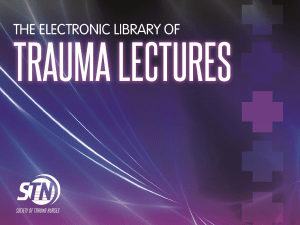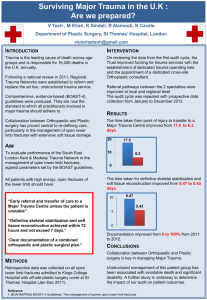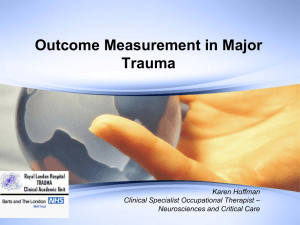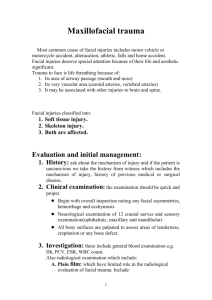Facial Trauma 2011 - Tidewater EMS Council
advertisement
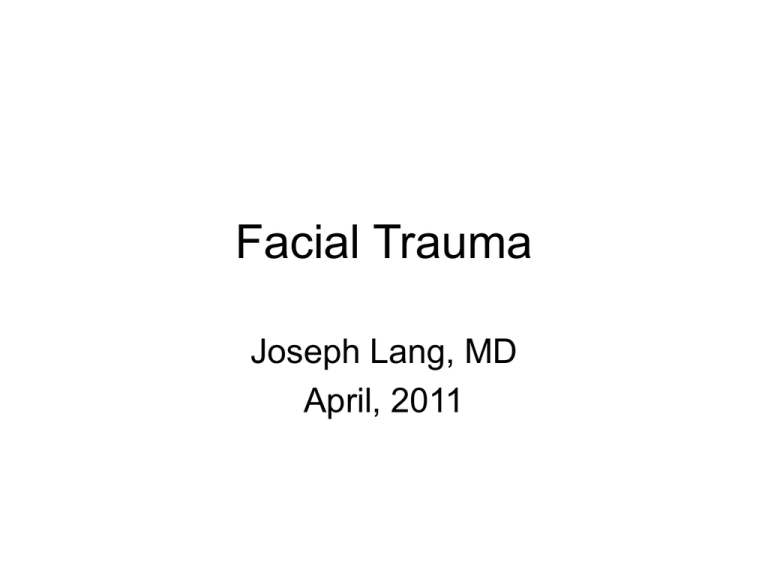
Facial Trauma Joseph Lang, MD April, 2011 Objectives • Discuss relevant anatomy and physiology • Discuss identification and emergent treatment ocular injuries • Discuss identification and emergent treatment of maxillo-facial injuries • Discuss identification and emergent treatment of dental and oral injuries Ocular Injuries • Eye trauma accounts for 1% of visits to ER • Often associated with facial fractures • Approximately 90% of injuries could be prevented with protective lenses Mechanisms of Injury • • • • Burn Blunt force Laceration/abrasion Penetrating Trauma Assessment • • • • Determine mechanism of injury Quick visual acuity Examine lids and periorbital structures Neurologic exam Ocular Burns • Assess what chemical, bring in bottle if possible • Remove contact lens if in place • Irrigate with saline 1000 cc by drip and remove any free foreign bodies Blunt Force • Fist, ball, heavy object • Direct trauma to globe – subconjunctival hemorrhage, globe injury • Injury to surrounding structures – orbital wall fractures, nerve injury, muscular entrapment or hematoma Blunt Force Management • • • • • • Visual acuity Cardinal movements Neurologic exam Do not let pt blow nose Cover area with saline soaked gauze Pain management Laceration/Abrasion • • • • Corneal layer is only 5-6 cells thick Abrasions heal in 2 days Possibility of globe rupture Usually does not require treatment in field except removal of loose foreign bodies, may irrigate in certain situations Penetrating Trauma • Visual acuity • Do not remove any objects in eye, stabilize area • Do not touch eye • We all want to see pictures… Maxillo-Facial Trauma • Blunt trauma much more common than penetrating • Airway issues of main concern • Neurologic issues • Hemorrhage • Other trauma Facial bones Facial Bone Strength • High impact – Supraorbital rim: 200 g – Symphysis mandible: 100 g – Frontal-glabellar: 100 g – Angle of mandible: 70 g • Low impact – Zygoma: 50 g – Nasal bone: 30 g Facial Fractures • • • • Nasal bone most common Look for fluid coming from nose (CSF) Cover area with gauze, ice if available Control bleeding with compression Frontal Bone Fracture • • • • One of the hardest bones to break Significant trauma Often associated brain/eye injury Cover any open areas with saline soaked gauze • Trauma center Orbital Injuries • Generally refers to structures surrounding globes • Need to assess globe and vision • Check extra ocular motion (EOM) • Do not let pt blow nose Zygoma Fractures • Refers to “cheekbones” • Zygoma fractures may affect vision, may also cause numbness on cheek due to nerve entrapment • Trismus Maxillary Fractures • Classified by Le Fort System • I – separates hard palate from bone • II – separates central maxilla and hard palate from rest of face • III – craniofacial disassociation – entire facial skeleton is removed Maxillary Fractures • If suspected, can use gentle pull on upper incisor area • Often associated with other structures such as blood vessels, nerve, parotid glands • Le Fort III almost always has CSF leak • Difficult airway Mandible Fractures • After nasal bone, most common fracture of face • Usually 2 fractures • Open or closed • May note malocclusion, numbness, dislocation • Look in preauricular area Mandible Fractures • Often have dental fractures or subluxed teeth • May have significant intra-oral debris • Airway issues • Screening test is bite stick test Mandibular Dislocations • Usually occur from motion that opens mouth widely – yawning, vomiting, singing • May occur from seizure or direct trauma • Anterior most common • May be unilateral or bilateral Pediatrics • Head is larger in proportion to body than in adults • Up to 60% of children with facial fractures have intracranial injury • Children more likely to have serious exsanguination from facial wounds than adults Oral Injuries • Includes dental and tongue injuries • Penetrating trauma • Airway issues Dental Avulsion • Primary tooth – implantation not done • Permanent tooth – mechanism, time out of socket, what tooth was lying in • Inspect tooth to see if intact • Inspect site of tooth loss Dental Avulsion Care • • • • Do not touch root or scrub tooth May use gentle saline irrigation If possible, attempt reimplantation in field If unable to reimplant in field, place tooth in transport medium – Hank’s solution, milk, saline Dental Fractures • 85% maxillary teeth • According to one medical website, lists the top causes, #6 is ice hockey Intra-oral Lacerations • May require suction • Can cover with saline dressings • If penetrating trauma, and object still in place, secure object and transport Facial Gunshot Wounds • High mortality, dependant on angle and bullet • Bullet may travel in unpredictable pattern • Airway nightmares Questions • ???


